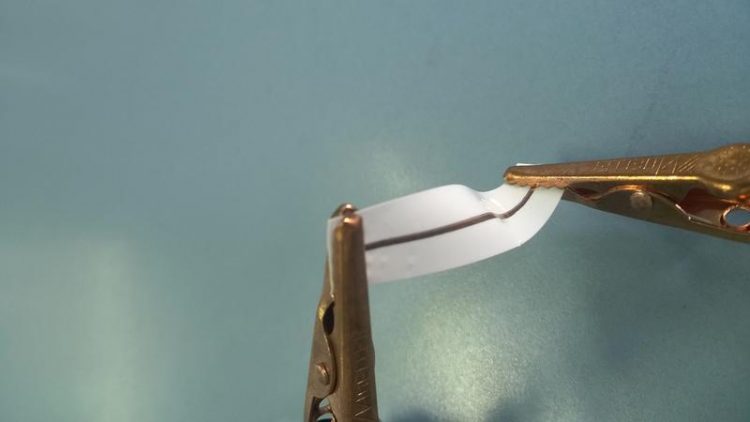Hannover Messe: Successful small-scale production of new hybrid inks

Flexible electronics with hybrid inks Source: INM; free within this press release
Conductive inks are widely used in to print electronics. They are suitable materials for flexible photovoltaics, lighting, touch screen electronics, wearable devices, large-area heaters, sensors, 3D conformal antennas, and health and biomedical applications, among others. Existing inks require annealing after inkjet printing before they become conductive.
“Our new hybrid inks become conductive immediately upon drying, are mechanically flexible, and compatible to inkjet printing,” explains the INM materials scientist Tobias Kraus.
“The hybrid inks contain a small organic polymer fraction that helps to maintain its electrical conductivity, even if the substrate material is bent,” Kraus continues. This enables printing on almost any substrate, like foil, paper, or textiles, since the final annealing steps at relatively high temperatures are avoided.
INM scientists have recently scaled the production of these hybrid inks to a level that is sufficient for small-scale production. “The scaling of nanostructured products requires optimized processes in order to maintain quality while lower prices,” says Kraus. Samples of the material are now available for testing applications.
Your expert at INM
Prof. Dr. Tobias Kraus
INM – Leibniz-Institute for New Materials
Head Structure Formation
Deputy Head InnovationCenter INM
Phone: +49681-9300-389
tobias.kraus@leibniz-inm.de
INM – Leibniz Institute for New Materials, situated in Saarbrücken, is an internationally leading centre for materials research. INM conducts research and development to create new materials – for today, tomorrow and beyond. Research at INM is performed in three fields: Nanocomposite Technology, Interface Materials, and Bio Interfaces. INM is an institute of the Leibniz Association and has about 240 employees.
Media Contact
All latest news from the category: Trade Fair News
Newest articles

Properties of new materials for microchips
… can now be measured well. Reseachers of Delft University of Technology demonstrated measuring performance properties of ultrathin silicon membranes. Making ever smaller and more powerful chips requires new ultrathin…

Floating solar’s potential
… to support sustainable development by addressing climate, water, and energy goals holistically. A new study published this week in Nature Energy raises the potential for floating solar photovoltaics (FPV)…

Skyrmions move at record speeds
… a step towards the computing of the future. An international research team led by scientists from the CNRS1 has discovered that the magnetic nanobubbles2 known as skyrmions can be…





















